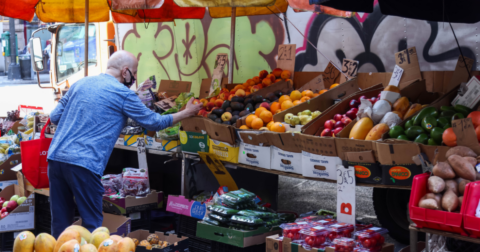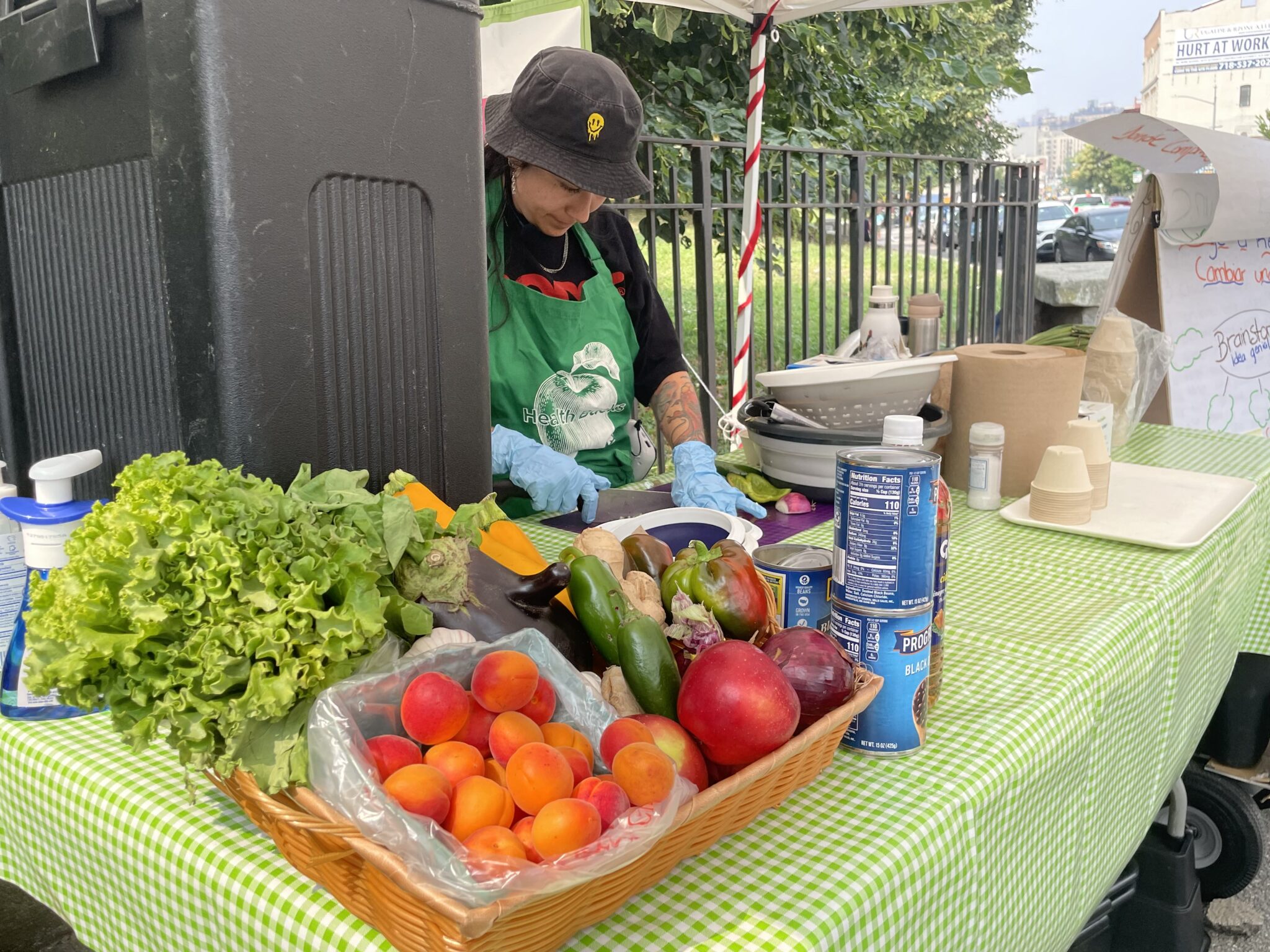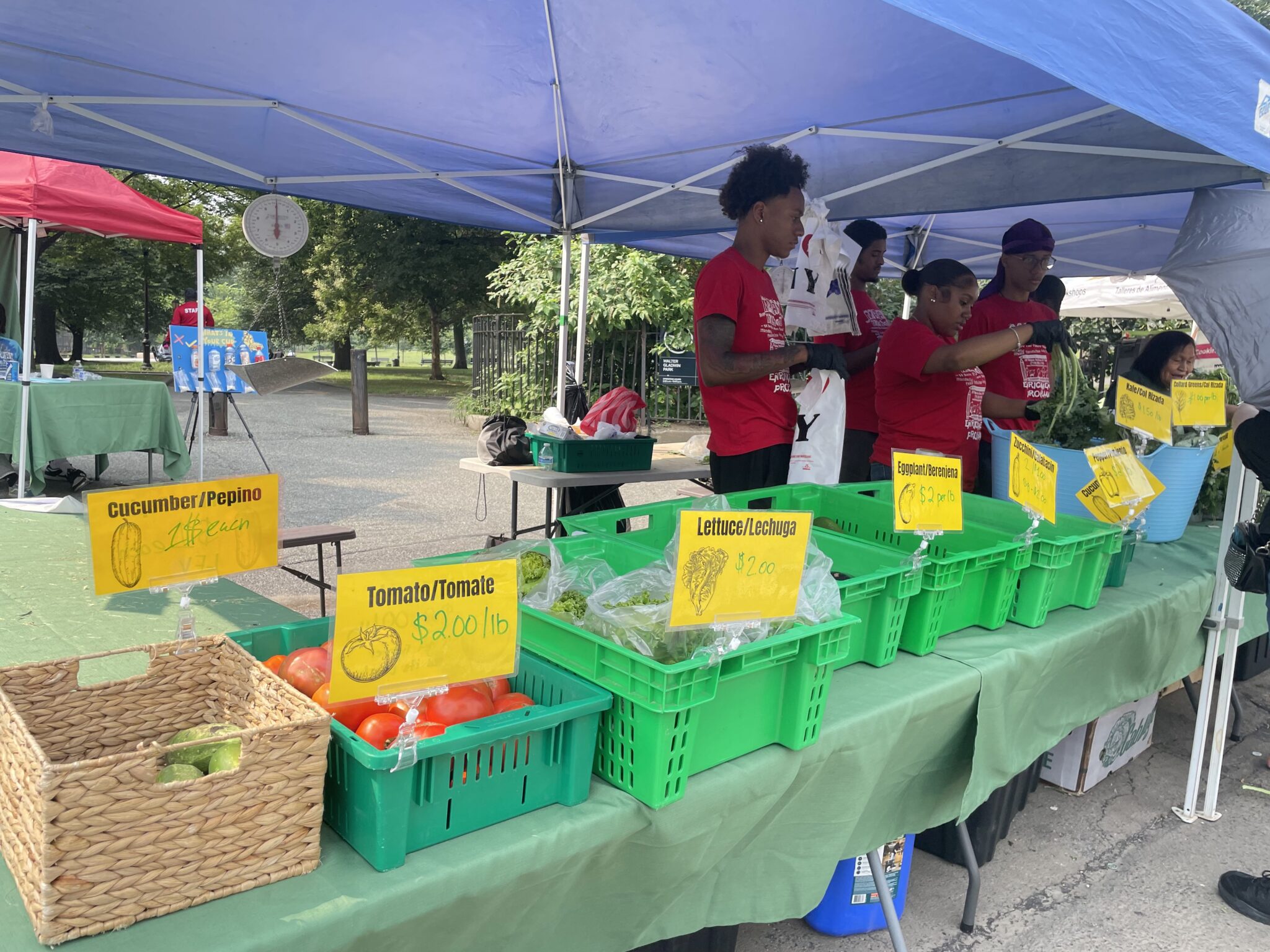Perspective
How Meat Became Cool Again in 2025
Diet•4 min read
Solutions
Coupons and community farms aim to bring more fruits and vegetables to those most often priced out.


Words by Gaea Cabico
Outside Walter Gladwin Park in the East Tremont section of the Bronx, a small crowd gathers around a farmers market stand to trade in red “Health Bucks” — $2 coupons from the New York City Department of Health — in exchange for fresh fruits and vegetables. The produce, which includes brightly colored tomatoes, cucumbers, carrots, eggplants, peppers and leafy greens, comes from urban gardens across the borough, and a Hudson Valley farm co-owned by Karen Washington, a food justice advocate with deep ties to the community. The aim is to boost access to healthy food. But this kind of dietary shift — more plants and less meat — is also good for the planet.
Globally, food systems are responsible for around a third of all greenhouse gas emissions. Most food-related emissions are driven by meat, especially beef, which makes the transition to a more plant-forward and sustainable food system all the more critical. People who follow the Planetary Health Diet — a research-backed eating pattern centered on minimally processed plant foods with modest amounts of meat and dairy — have a lower risk of premature death from heart disease, cancer and respiratory illnesses, according to a study by the Harvard T.H. Chan School of Public Health.
“We pick up everything the day-of, so it’s harvested by the farmers the day before,” Aleyna Rodriguez-Sanes, executive director of Mary Mitchell Family and Youth Center, which organizes the La Familia Verde Farmers Market, tells Sentient. That day, they were selling prickly cucumbers for the first time, to see if community members were interested in the variety.
A few feet away, volunteers are explaining the health risks of high sugar intake, and how much sugar is in the soda and energy drinks many Bronx residents enjoy. Passersby stop to listen and, in return, receive Health Bucks to spend on produce.
At one stall, nutrition educator Keion Jñobaptiste dives into a few ways to make meals budget-friendly while meeting the health needs of community members, with a translator relaying her words in Spanish. She urges attendees to get vegetables that are in-season, swapping beans for meat when possible, adding that beans are “a great protein substitute.”
Beside her, a partner demonstrates how to make a black bean and pepper dish using ingredients found at the farmers market. Community members, required to participate in the demo to earn coupons worth $4, watch closely.
These scenes are part of a growing city government and community-driven effort seeking to bring affordable, nutritious and plant-forward foods into a low-income neighborhood where fast food and processed snacks are often more readily available. The need for such initiatives is clear: bodegas with limited produce and fast food chains outnumber supermarkets in the borough.
Healthy Bucks and the Stellar Markets are government programs, but they are also community partnerships, working with grassroots organizations like Mary Mitchell Family and Youth Center, which organizes La Familia Verde Farmers Market.
“What we do is to get the community members to eat more fruits and vegetables, and understand the importance of healthy eating,” Jñobaptiste, who works with the city’s Stellar Farmers Markets Program, tells Sentient. The initiative offers cooking demonstrations and nutrition education workshops — covering everything from budgeting to incorporating more produce — at farmers markets across the city.
Such initiatives are necessary in the Bronx, where the median household income in 2023 was $48,610 — roughly 39 percent below the citywide median. The borough, whose residents are predominantly Hispanic and Black, had a poverty rate of 27.9 percent , compared with 18.2 percent citywide.

For its part, the New York City government has invested in programs aimed at making food production and distribution more sustainable, and increasing equitable access to healthy foods in disadvantaged neighborhoods. Through the Shop Healthy NYC initiative, the city partners with food stores in areas with high rates of diet-related diseases in order to promote and stock healthier products. Meanwhile, SNAP/EBT users can get free fruits, vegetables and beans through the Get the Good Stuff program, which matches every dollar spent on eligible items — up to $10 per day.
The Mary Mitchell Family and Youth Center now operates La Familia Verde — a coalition of five community gardens in the Bronx — to improve access to nourishing, climate-friendly food. Every Tuesday, the center runs a farmers market featuring fresh produce grown at The Garden of Happiness, The Garden of Youth, Clinton Ave Garden, Tremont Community Garden and Fordham Lot Busters — all in the Bronx tended by volunteers — as well as from Rise and Root Farm, a five-acre farm in the village of Chester, about 60 miles from New York City.
Nearly everything at the market is priced under $3. Aside from Health Bucks, food stamps and Farmers’ Market Nutrition Program coupons are also accepted.
“Carrots are $2 a bunch and it’s a hearty bunch. Beets are $2 a bunch. Potatoes are 50 cents a pound. So we try to make sure that if they’re only spending $5, they can get a nice quantity,” Rodriguez-Sanes says. Some items, like heirloom tomatoes, cost a bit more. But even then, if someone only has $2 and wants them, Rodriguez-Sanes says they won’t be turned away. “Our goal is connecting them to food.”
It comes down to health equity, Alexina Cather, a member of the Hunter College New York City Food Policy Center Carter, told Sentient in an email. “Communities in the Bronx have been structurally denied the same food access and health outcomes as wealthier neighborhoods,” she wrote. In New York City, areas like the South Bronx, East and Central Harlem and North and Central Brooklyn have higher rates of premature deaths, diabetes and hypertension, compared to the city average.
Research shows that when communities have access to fresh, nutritious produce from local farms, it can translate into better diets, and ultimately, improved health outcomes. For instance, a 16-week program in California that delivered free, locally-grown fruits and vegetables to low-income patients improved diets, boosted physical activity and lowered cholesterol and blood sugar levels.

Eating locally grown produce can also foster a sense of community. “What we’re doing is we’re letting the community know, ‘Hey, this isn’t from Hunt’s Point Market, coming from who knows where,” says Rodriguez-Sanes. (She is referring to the country’s largest food distribution hub, which supplies millions of pounds of meat, seafood, fruits and vegetables to grocery stores, bodegas and restaurants across New York City and the broader tri-state area.)
When it comes to the produce at La Familia Verde Farmers Market, Rodriquez-Sanes adds, “I can give you the exact coordinates for where this was, who harvested it, when it was harvested. I feel like that has opened up the community more to us, and built upon that conversation of understanding our food system and how to support our farmers.”